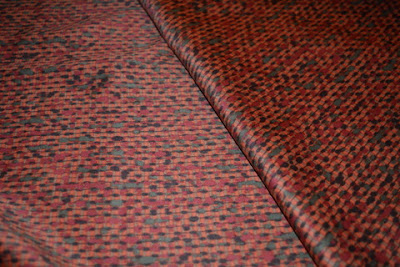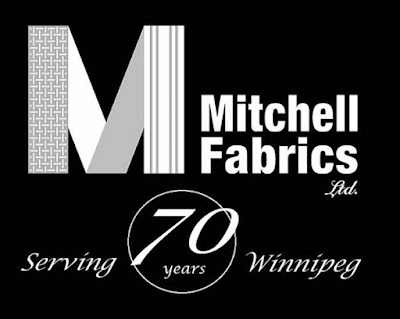So the big question is how did I do with this year's Me-Made-May pledge.
I feel that I can check this one off as accomplished, even though it is a work in progress. The fabrics that tend to last and look the best after several wears and washes are those with natural fibre content.
In the news there has been reports on how micro-plastics have been polluting our waters and wildlife. It is not just from discarded water bottles and plastic food wraps or plastic bags, fleece fabrics have also been singled out. The fabric choices that I make as a consumer have a far reaching impact beyond my sewing workspace and closet. It is not only fleece, the shelves at fabric stores are filled with dubious fibre content labels. The California Proposition 65 labels appear here on clothing and handbags found in the retail landscape. I just wish that it applied to fabric sold in the fabric stores and that we had a similar system here in Canada to help consumers make informed decisions. Even without these labels, I know that I prefer natural fibres and more of my sewing projects are reflecting this bias.
Be more mindful of the environmental impact of my sewing decision.
This is an ongoing learning process. This goes beyond choosing the "right" or ethical fabric. I have to constantly be mindful of the waste that goes on during the cutting process. I tend to collect a lot of scraps and I have to remind myself that yes, one person's trash is another's treasure.
I collect piece of fabric to donate to my school teacher friends for craft and school projects. When I worked at a school and ran the sewing club, some of the older students used to come to me to ask if I had a "piece of fabric" because they forgot to bring some and it was a shops day. And you should have seen how thrilled the students were when I brought in a collection of fabric pieces. They would create toys for their pets, headbands, and bracelets. It was great to see how excited their creative minds were at the sight of craft supplies. And I should be more careful with how much fabric I buy to cut down on the left-over scraps that are left behind. I'll admit that I tend to pick up a little more than what I typically need for a project, "just in case."
Part of the sewing process entails pre-treating the fabrics before I cut out a project. I realize that the way I chose to prewash and shrink my fabric also has an environmental impact. I've noticed that vintage sewing books offer pretreatment solutions that are less harmful to the environment than the methods I sometimes use out of convenience.
Pass along the clothes that don't fit.
Check, but it is also an on-going progress.
Replace the clothes that don't fit with items that reflect my life-style and values.
Again this is an on-going process. I didn't take daily photos of what I wore during the month of May but I can tell you that everyday is a me-made-day. During the month, I wore more trousers than I did dresses which kind of shocked me. I don't own any RTW trousers for the simple fact that I can't find any that fit. I could use more and this month I found a wonderful bias cut pattern that I just need to tweak the fit and I'll be working on the next few weeks. And there is one more tee-shirt on the cutting table.
Well, that's my Me-Made-May 2017 round-up. I won't say, until next year because what I've learned from this year is that it's an on-going process and everyday is a me-made-day.
Happy Sewing!
I Graça, of Sew Essentially Sew, sign up as a participant of Me-Made-May 2017. I plan on being more mindful of the fabrics that I chose to wear, the environmental impact of my sewing decisions, and to pass along the clothes that don't fit and replace them with items that reflect my life-style and values.Be more mindful of the fabrics that I chose to wear.
I feel that I can check this one off as accomplished, even though it is a work in progress. The fabrics that tend to last and look the best after several wears and washes are those with natural fibre content.
In the news there has been reports on how micro-plastics have been polluting our waters and wildlife. It is not just from discarded water bottles and plastic food wraps or plastic bags, fleece fabrics have also been singled out. The fabric choices that I make as a consumer have a far reaching impact beyond my sewing workspace and closet. It is not only fleece, the shelves at fabric stores are filled with dubious fibre content labels. The California Proposition 65 labels appear here on clothing and handbags found in the retail landscape. I just wish that it applied to fabric sold in the fabric stores and that we had a similar system here in Canada to help consumers make informed decisions. Even without these labels, I know that I prefer natural fibres and more of my sewing projects are reflecting this bias.
Be more mindful of the environmental impact of my sewing decision.
This is an ongoing learning process. This goes beyond choosing the "right" or ethical fabric. I have to constantly be mindful of the waste that goes on during the cutting process. I tend to collect a lot of scraps and I have to remind myself that yes, one person's trash is another's treasure.
Part of the sewing process entails pre-treating the fabrics before I cut out a project. I realize that the way I chose to prewash and shrink my fabric also has an environmental impact. I've noticed that vintage sewing books offer pretreatment solutions that are less harmful to the environment than the methods I sometimes use out of convenience.
Pass along the clothes that don't fit.
Check, but it is also an on-going progress.
Replace the clothes that don't fit with items that reflect my life-style and values.
Again this is an on-going process. I didn't take daily photos of what I wore during the month of May but I can tell you that everyday is a me-made-day. During the month, I wore more trousers than I did dresses which kind of shocked me. I don't own any RTW trousers for the simple fact that I can't find any that fit. I could use more and this month I found a wonderful bias cut pattern that I just need to tweak the fit and I'll be working on the next few weeks. And there is one more tee-shirt on the cutting table.
Well, that's my Me-Made-May 2017 round-up. I won't say, until next year because what I've learned from this year is that it's an on-going process and everyday is a me-made-day.
Happy Sewing!















































.jpg)